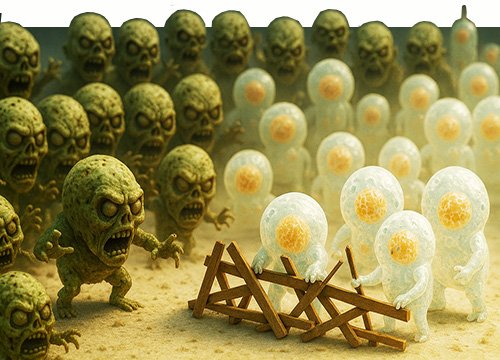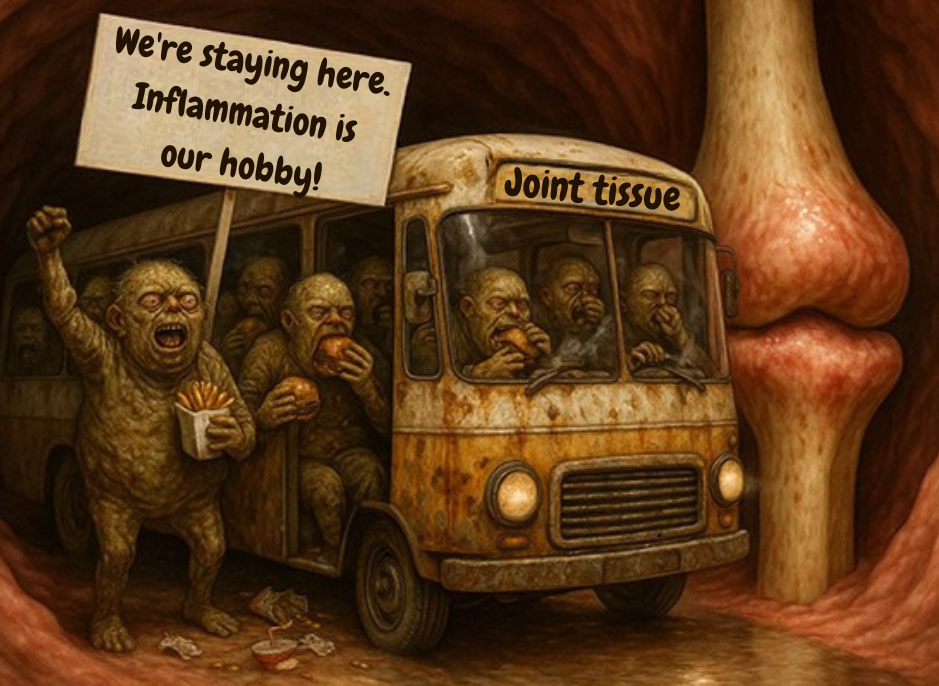by Dr.Harald Wiesendanger– Klartext
What the mainstream media is hiding
Trillions of zombies haunt our bodies – cells that no longer divide but also do not die properly. These biological undead pose a massive threat to our health. How do they come into being? What damage do they cause? How can we get rid of them?

Hollywood’s spine-chillers show us how to kill zombies: destroy the brain – whether with a shot to the head, an axe, a machete, a brick or a sledgehammer! Off with their heads! Burn them!
But no horror movie, video game or comic book shows us how to get rid of the countless undead inside us: cells that no longer divide but also do not die properly – hence the nickname “zombie cells”. Biologists call them ‘senescent’, derived from the Latin word “senescere” – to age. Although a senescent cell is still alive, it can only perform its actual tasks to a limited extent. It has been permanently retired, so to speak, but is still active – like an office worker who no longer works but still comes to the office every day, continues to take up space and resources, and hangs around uselessly. He constantly interrupts, constantly demands attention, and gets on everyone else’s nerves. Such a retired cell is like a broken smartphone in continuous operation: it can no longer be restarted, but it remains on and constantly sends error messages.
Senescent cells are not just lazy – they poison their environment. Still metabolically active, they release a variety of harmful messenger substances – including pro-inflammatory cytokines, growth-promoting factors, and enzymes that can damage surrounding tissue. Scientists refer to this as SASP, or “senescence-associated secretory phenotype.” This cocktail of signaling molecules can affect healthy cells, even causing them to become senescent themselves. It’s like a grumpy retiree in the office who not only refuses to lift a finger, but also infects all his colleagues with his bad mood and encourages them to quit. He constantly warns them with loud SASP cries – even when there is no longer any danger. In doing so, he blocks communication channels – like someone who never hangs up the phone.

How many such useless people are haunting us? That depends largely on our age and state of health. Of the 30 to 40 trillion cells that make up our bodies, less than 1% are affected in young people, and up to 5% in healthy 30- to 50-year-olds. In older people over the age of 65, the zombie proportion reaches up to 15%, and in some tissues, over 20%. In certain organs of chronically ill people, it is as high as 30%. Even a senescence rate of just one percent would therefore correspond to 300 to 400 billion zombie cells.
Professor Judith Campisi, a pioneer in this field of research, speaks of a “garbage problem in the body” (https://www.ncbi.nlm.nih.gov/pmc/articles/PMC3199212/), because our immune system becomes increasingly less able to eliminate zombie cells as we age. Gerontologists estimate that one in ten cells in the body can become senescent in old age. And none of them contribute to regeneration.
Where do these undead cells come from?
Ultimately, the problem stems from the fact that the marvel that is our body is never finished, but remains a permanent work in progress, from our first breath to our last. Cells are constantly being broken down, rebuilt, and rebuilt—in the single second it took you to read the headline of this article, around 50 million cells in your body were renewed.
What happens when a cell is stressed, receives too few nutrients, is damaged, or ages?
Three fascinating processes then take place, finely tuned to each other; they differ fundamentally in their function, mechanism, and goal. A cell chooses between them depending on the type and extent of the danger—a constant balancing act. https://www.fightaging.org/archives/2018/10/judith-campisi-on-senolytics/ A healthy system needs all three, but in the right dosage. Otherwise, cancer, chronic inflammation, or premature aging can occur.
The first line of defense, so to speak, is autophagy: According to the motto “I’ll keep fighting,” the cell tries to clean itself up and purify itself in order to save itself. To do this, it recycles its own components, such as damaged cell organelles or misfolded proteins. It encloses them in so-called autophagosomes and breaks them down in lysosomes, small “digestive organelles” enclosed by a membrane.
But what if the cell is superfluous, too badly damaged, or dangerous, e.g., cancerous?
Then the “garbage disposal” remains inactive. Instead, apoptosis takes place: according to the motto “I’m doing it for the greater good,” the cell prefers to commit suicide rather than pose a risk to the body. A genetically controlled self-destruction mechanism causes it to shrink and disintegrate into small vesicles—so-called apoptotic bodies—which are eliminated by scavenger cells (phagocytes). Immunologist and cell biologist Peter H. Krammer calls this phenomenon of programmed suicide “the biological art of dignified departure” – in contrast to uncontrolled suicide: While necrosis is more like an exploding garbage truck, apoptosis is the orderly dismantling of an old building – brick by brick, without debris on the street.
A third strategy – based on the motto “I’ll stay, but I’ll keep quiet” – is senescence. At first glance, it seems paradoxical: a cell continues to live but can no longer divide.
By no means completely useless
But biologically speaking, senescence is by no means a design flaw, but rather an evolutionary protective and repair mechanism, at least in the short term. Complete destruction cannot, therefore, be the goal – this is what distinguishes the mini-undead in us from the zombies that shuffle mindlessly and bloodthirstily through apocalyptic movie landscapes. Senescent cells may have a terrible image, but they are not fundamentally evil and harmful without exception. In several respects (https://rupress.org/jem/article/221/4/e20232136/276573/Cellular-senescence-Neither-irreversible-nor), they can also be useful, even vital.
For example, they promote wound healing, not by multiplying themselves—they can no longer do that—but by stimulating neighboring cells that are still capable of division to proliferate, i.e., to multiply by division in order to form new tissue. How? When an injury occurs, such as a cut in the skin, many cells die or suffer damage. Some then switch to a senescent state – they stop dividing but remain alive. They send out SOS signals: a cocktail of messenger substances known as SASP. These substances do not have a regenerative effect on the senescent cell itself, but stimulate the surrounding healthy cells. Among other things, growth factors such as PDGF and VEGF are released, which stimulate repair. Cytokines such as IL-6 and IL-8 promote inflammatory reactions to activate the immune system. So-called matrix metalloproteinases (MMPs) break down damaged tissue. Once enough new cells have formed, senescent cells send stop signals to prevent the tissue from growing excessively, which could lead to scarring or tumors. They then usually disappear again, eliminated by certain immune cells called macrophages.
The zombie phenomenon also contributes to cancer prevention. When a cell is at risk of degeneration due to DNA damage, oxidative stress, or telomere shortening, senescence stops its cell division. This prevents the cell from becoming a tumor focus. Without this mechanism, damaged cells would continue to grow, causing cancer rates to skyrocket.
Senescent cells already develop in the embryo – they direct the growth of surrounding tissue, help fingers and all other limbs, organs, and nerves to develop in the right place, and are involved in removing superfluous cell groups. Without them, there would be no clean “building site order” in the body. Senescent cells send control signals to surrounding cells using signaling molecules that stimulate stem cells to differentiate and activate or slow down cell division in neighboring cells. They do not act as placeholders, but as conductors: they play their role, orchestrate the blueprint – and disappear. In other words, senescence occurs in the embryo according to plan. (1)
Senescent cells also play a role in defending against infection: they send signals that alert the immune system when something is wrong in the tissue. They can help recognize viruses or mark damaged neighboring cells.
Useful in the short term, harmful in the long term – when does senescence become a problem?
Senescent cells only become problematic when they proliferate with advancing age and are not broken down in time – e.g., due to a weaker immune system – but remain in the tissue. Then the protective mechanism becomes a risk factor. And only then do we have reason to fear a flood of biological “undead.”
The main trigger for zombie inflation is the natural aging process: with each cell division, the so-called telomeres, protective caps at the ends of chromosomes, become shorter. If they are too short, the cell concludes that its time has come and stops dividing.
Damage to DNA – caused, for example, by UV radiation, environmental toxins, inflammation, or oxidative processes – can also drive a cell into senescence. Infections or certain medications, such as chemotherapeutics, can also trigger this condition.
Then our organism pulls the emergency brake: better not to divide than to degenerate.
What damage do these “undead” cells cause in our bodies?
Numerous chronic diseases are associated with an excess of senescent cells. By constantly secreting messenger substances such as interleukin-6 and TNF-alpha, they promote chronic inflammation.
This makes them a risk factor for Alzheimer’s and other forms of dementia, Parkinson’s and ALS, and autoimmune diseases such as rheumatoid arthritis, multiple sclerosis, Crohn’s disease, and ulcerative colitis.
In blood vessels, they promote the development of atherosclerosis.
They promote tumor growth.
In the pancreas, they contribute to insulin resistance, thereby promoting the development of type 2 diabetes.
Osteoporosis, osteoarthritis, certain types of cancer, pulmonary fibrosis, and even age-related muscle weakness are also associated with their activity.
Particularly after chemotherapy, many senescent cells often remain in the body, which could explain long-term late effects.

How can we get rid of our zombies?
Mice whose senescent cells were regularly removed by researchers lived longer, were healthier, and showed fewer age-related diseases, as a groundbreaking study found back in 2011.
(2) The observed correlation was so clear that it triggered a boom in studies on “senolytics” – active substances that can specifically remove zombie cells from the body. “Senolytics open up completely new avenues in geriatric medicine,” enthuses Dr. James Kirkland of the Mayo Clinic. (3)
Pharmaceutical companies sense a lucrative business opportunity: analysts at https://www.verifiedmarketreports.com/product/senolytic-drug-market/ estimate that the senolytic market could grow to US$7.5 billion by 2033. Half a dozen substances are currently in the pipeline. Over 30 clinical trials are underway or planned worldwide. Dasatinib, trade name Sprycel, originally a drug for leukemia, is already being used in human studies and off-label. It inhibits certain enzymes, known as tyrosine kinases, which are overactive in senescent cells, making them vulnerable to apoptosis. However, side effects have hardly been researched.
Nature, on the other hand, provides us with senolytics that have no side effects: Quercetin, for example, is a highly effective plant substance found in onions, berries, cabbage, and especially capers. In animal experiments (4), but more recently also in human studies (5), it made dasatinib effective in the first place. (On top of that, it protects the heart, reduces inflammation, and alleviates colds.)
Fisetin, a yellowish flavonoid found in strawberries, also appears to induce programmed cell death — at least when the cells are senescent. (6)
Lifestyle also influences how many zombie cells accumulate in the body. We largely have it in our own hands to slow down the zombie flood: Those who exercise regularly, eat a balanced diet, get enough sleep, and avoid stress have a better chance. Fasting, especially intermittent fasting, appears to promote autophagy. Cold and heat stimuli — such as saunas or cold showers — also activate repair processes at the cellular level. And, of course, a diet rich in phytochemicals helps prevent cell damage. Plant substances such as curcumin (from turmeric), resveratrol (from red grapes), and a fiber-rich diet can contribute to the natural mitigation of SASP and keep zombie cells at bay.
Why is a healthy lifestyle more sensible than a pharmaceutical product? Prevention instead of repair: better to prevent than to have to clean up later. Healthy habits prevent the formation of excessive senescent cells – senolytics combat them after the fact.
Furthermore, there are currently no approved anti-zombie cell agents. Many are in preclinical or early clinical phases. Side effects, dosages, and long-term effects are unclear – they may damage healthy cells. Do senolytics potentially prevent senescent cells from performing their useful functions? Yes, this risk certainly exists if they are used indiscriminately and continuously – this is one of the central risks and ethical questions in senolytic research. Therefore, the amount and timing of administration, the target tissue, and the choice of active ingredient are crucial.
A healthy lifestyle, on the other hand, has been tried and tested for thousands of years – it is low-risk, sustainable and has guaranteed additional benefits for the heart, brain, metabolism and psyche.
Not to forget: lifestyle factors such as fasting, exercise, sleep, stress reduction, and a plant-based diet are not single-purpose weapons, but have an enormously broad effect: They are senomorphic–senescent cells become calmer and less harmful, stimulate autophagy, inhibit inflammation, and strengthen the immune system. The body disposes of most zombie cells itself – provided we treat it in such a way that it has the chance to do so.
It is tempting to spare yourself the effort of a healthier lifestyle by taking dietary supplements. Combination preparations of quercetin and fisetin are touted as a convenient shortcut. (https://www.amazon.de/Hochdosiert-Absorption-Nat%C3%BCrliche-Senolytikum-Cestfilo/dp/B0B6NGGKFV?th=1&linkCode=sl1&tag=zdg0e-21&linkId=5f90f52a2357801455ff010e242a244e&language=de_DE&ref_=as_li_ss_tl) Dagegen spricht eine sehr geringe Bioverfügbarkeit: After ingestion, too little of the active ingredient remains active in the body – less than 2% (quercetin) or 5% (fisetin). This is because both are hardly soluble in water in the small intestine, which is why they remain bound in the digestive pulp instead of entering the bloodstream; both can be easily broken down by enzymes; both are destroyed or excreted quite quickly by the liver.
The body absorbs piperlongumine, an alkaloid from “long pepper,” much better, at 10 to 25%. However, this senolytic is also broken down quickly and has a short half-life. In addition, there are no human studies available for it yet.
Consider the approximately 600,000 centenarians worldwide, those over 100 years of age: how many of those who have remained healthy have ever swallowed any isolates from the range of enterprising supplement manufacturers?
Kindred spirits: senescence, horror, and CO2 paranoia
Conclusion: Zombie cells are not science fiction. These undead creatures exist. They arise in every body as it ages or is under stress. And they are anything but harmless. But they don’t have to be our fate. Whether through new drugs, dietary supplements, or a healthy lifestyle, the hunt for the biological undead has long begun—for a more carefree aging process, fewer chronic diseases, and perhaps even a longer life. But we shouldn’t exaggerate this hunt.
Isn’t the senescence horror prevalent among the supposedly health-conscious similar to the carbon dioxide paranoia (https://www.klartext-online.info/post/wer-hat-angst-vor-co2) of overzealous climate activists? Yes, CO2 contributes to the greenhouse effect – but does that mean it has to be removed from the atmosphere as an “environmental toxin”? Without CO2, there would be no life on our planet. And without senescence, our bodies would not be healthier, but sick.
Comments
(1) See e.g. Muñoz‑Espín et al.: “Programmed cell senescence during mammalian embryonic development”, Cell 155 (2013), S. 1104–1118, DOI: 10.1016/j.cell.2013.10.019, https://www.nature.com/articles/nrm3731, https://pubmed.ncbi.nlm.nih.gov/24238962); Mekayla Storer u. a.: “Senescence is a developmental mechanism that contributes to embryonic growth and patterning”, Cell 155 (2013), S. 1119–1130, DOI: 10.1016/j.cell.2013.10.041, https://pubmed.ncbi.nlm.nih.gov/24238961/, https://www.nature.com/articles/nrm3731.
(2) Darren J. Baker u.a.: “Clearance of p16Ink4a-positive senescent cells delays ageing-associated disorders”, Nature 479 (2011), S. 232-236, https://www.nature.com/articles/nature10600
(3) James L. Kirkland/Tamara Tchkonia: “Cellular Senescence: A Translational Perspective”, EBioMedicine 21(C) April 2017, DOI:10.1016/j.ebiom.2017.04.013, https://www.researchgate.net/publication/316041459_Cellular_Senescence_A_Translational_Perspective.
(4) Yi Zhu et al.:”The Achilles’ heel of senescent cells: from transcriptome to senolytic drugs”, Aging Cell 22, April 2015, S. 644-658, DOI:10.1111/acel.12344, https://pmc.ncbi.nlm.nih.gov/articles/PMC4531078/
(5) Hickson/Justice et al.: “Senolytics decrease senescent cells in humans: Preliminary report from a clinical trial of Dasatinib plus Quercetin in individuals with diabetic kidney disease”, EbioMedicine 47, September 2019, S. 446–456, https://pubmed.ncbi.nlm.nih.gov/31542391/
(6) MJ Yousefzadeh MJ, LJ Niedernhofer u.a.: “Fisetin is a senotherapeutic that extends health and lifespan”, EbioMedicine 36, Oktober 2018, S. 18-28, https://www.sciencedirect.com/science/article/pii/S2352396418303736

